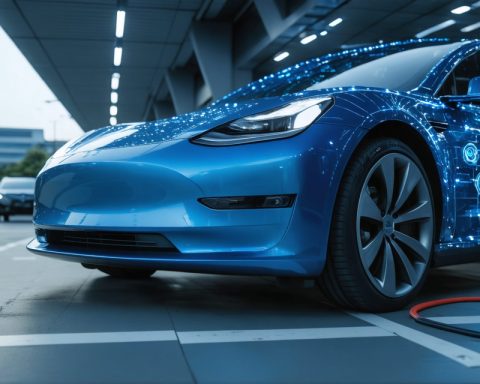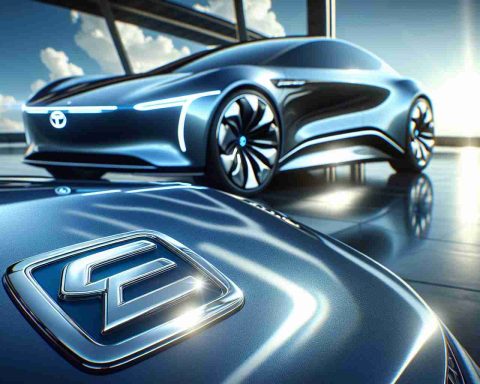- Electric vehicles (EVs) are transforming urban environments by replacing gasoline engines with lithium-ion batteries, reducing greenhouse gas emissions and contributing to climate change mitigation.
- EV charging infrastructure is reshaping city architecture, with parking lots becoming energy hubs and public transit systems adopting cleaner, quieter electric options.
- Cities are adapting by creating “green zones” and offering incentives to boost EV adoption, fostering sustainable urban ecosystems.
- Advancements in battery technology, including the development of solid-state batteries, promise greater efficiency and safety, revolutionizing energy storage.
- Ethical sourcing of battery materials like lithium, cobalt, and nickel remains a challenge, emphasizing the need for sustainable and responsible practices.
- EVs symbolize progress, driving society forward into a more sustainable future where innovation and environmental preservation coexist.
The gentle hum of electric vehicles (EVs) now graces city streets worldwide, spearheading a revolution beneath their hoods—lithium-ion batteries. These powerhouses not only electrify transportation but also reshape urban landscapes and redefine efficiency standards for modern living.
The shift from gasoline to electric propulsion significantly impacts environmental footprints. Unlike their fossil-fueled counterparts, EV batteries provide a clean, renewable source of energy, reducing greenhouse gas emissions in bustling metropolises. This transition plays a vital role in efforts to curb climate change, granting urban areas a breathable reprieve.
Yet, the influence of these batteries extends beyond pollution reduction. Envision city architecture sculpted by the needs of charging infrastructure. Parking lots evolve into charging oases, where vehicles sip energy like a parched traveler at an oasis. Public transit systems harness this technology, with e-buses seamlessly gliding through traffic, whispering promises of a quieter, cleaner commute.
Urban planning itself bends to the will of EV batteries, encouraging the creation of “green zones” where fossil fuel engines become relics of the past. This push drives cities to innovate, offering incentives for residents to adopt EVs, thereby fostering a sustainable urban ecosystem.
The power of innovation propels advancements in battery technology at a dizzying pace. Engineers strive to craft more efficient, longer-lasting batteries that charge in the blink of an eye. As solid-state batteries loom on the horizon, their potential for increased range and safety threatens to outpace current technology, promising a revolution in energy storage.
Despite the myriad advantages, challenges persist. The ethical sourcing of lithium, cobalt, and nickel—crucial components of EV batteries—poses environmental and human rights concerns. The race is on to develop methods that prioritize sustainability and ethical accountability, ensuring a brighter future for both people and the planet.
The narrative of EV batteries intertwines with our daily lives, weaving a story of progression and possibility. As these silent forces propel cars into a new era, they also accelerate communities toward a cleaner, more vibrant tomorrow. Embracing this transformation positions society at the forefront of innovation, redefining not just how we move, but how we live.
In this electrifying dance of technology and humanity, EV batteries have a starring role, powering us toward a world that values both progress and preservation. The takeaway? Every time an EV silently sweeps by, it carries more than passengers—it carries the promise of a sustainable future.
The Future of Urban Mobility: How Electric Vehicles and Advanced Batteries Are Transforming Cities
The unmistakable transition from gasoline-powered vehicles to electric vehicles (EVs) is not merely an evolution in transportation; it’s a profound transformation shaping cities across the globe. This shift, underpinned by the innovative use of lithium-ion batteries, is poised to redefine urban living, environmental sustainability, and technological progress.
The Environmental Impact of EVs
A primary catalyst for the EV revolution is the urgent need to reduce greenhouse gas emissions. Traditional gasoline vehicles have long been a significant source of urban pollution, contributing to climate change and health issues in densely populated areas. In contrast, EVs offer a cleaner alternative. According to the International Energy Agency, EVs can reduce carbon dioxide emissions by 50% to 60% compared to internal combustion engines over their lifecycle, from production to operation.
Infrastructure and Urban Design
The widespread adoption of EVs necessitates the evolution of city infrastructures. Urban planners are now focusing on creating robust charging networks to support the increasing number of electric vehicles. Here are some emerging trends:
– Smart Charging Stations: Imagine smart parking lots equipped with fast-charging stations, tethered to renewable energy sources like solar panels. These setups allow for seamless integration of EVs into daily life.
– Public Transportation: E-bus fleets are transforming public transport, reducing noise and air pollution. Cities like Shenzhen, renowned for its comprehensive electric bus network, highlight the potential for cleaner urban travel.
– Zoning and Incentives: Cities are designating “green zones” to prioritize EV traffic. Places like Oslo incentivize EV use by offering benefits like reduced tolls and tax reductions, fostering a culture of sustainable travel.
Battery Technology Advancements
The future of EVs lies in battery technology innovation. Presently, most EVs rely on lithium-ion batteries, but solid-state batteries are on the horizon. These batteries promise:
– Increased Range and Longevity: Solid-state batteries can potentially offer vehicles a range of over 600 miles on a single charge, significantly delaying the depreciation rate of the battery.
– Faster Charging: New technologies may allow for full charging in under 10 minutes—a game-changer for long-distance travel.
– Safety Enhancements: Solid-state batteries reduce the risk of leaks and overheating, offering a safer power solution.
Challenges in EV Battery Production
Behind the promising facade of EVs lie challenges, particularly concerning the ethical sourcing of key materials like lithium, cobalt, and nickel. Current extraction processes can lead to environmental degradation and raise human rights concerns. Here are issues and potential solutions:
– Ethical Sourcing: Companies like Tesla and Apple are engaging in supply chain audits to ensure that their materials are ethically sourced, fostering responsible practices.
– Recycling and Sustainability: Advancements in battery recycling technologies aim to reduce the environmental impact. Companies are researching methods to recover up to 80% of lithium-ion components for reuse.
Actionable Steps for Adopting EVs
– Research Charging Options: If you’re considering switching to an EV, investigate local charging station availability and home charging capabilities.
– Evaluate Total Cost of Ownership: Consider not only the purchase price but also the long-term savings on fuel and maintenance.
– Explore Government Incentives: Many regions offer tax credits, rebates, and other incentives to offset the initial cost of EVs.
For more insights on electric vehicles and urban sustainability, visit International Energy Agency.
As cities adapt to and embrace electric vehicles, they are not only exploring a solution for cleaner transportation but also redefining the scope of modern urban life, paving the way for a sustainable future.



















